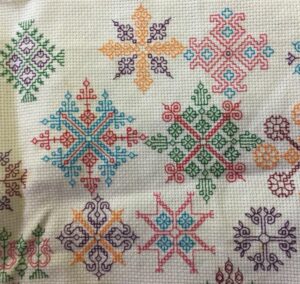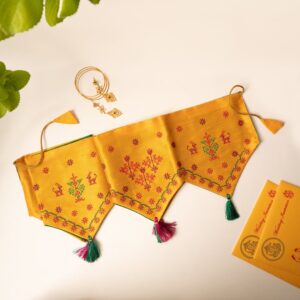Walk through any traditional home in Karnataka, and you might find a doorframe dressed with colour, geometry and memory. That’s what Kasuti embroidery feels like—an art that doesn’t raise its voice, but draws you in with quiet precision.
 Kasuti (from kai – hand, and suti – cotton thread) is said to have begun in the royal courts of the Chalukya and later the Mysore kingdoms. Women, often without formal design tools, counted threads on their sarees to create palaces, temple towers, oil lamps, elephants, birds and tulsi kattes—each stitch a tribute to the world around them. What makes Kasuti remarkable is its discipline: no knots, no loose ends, and generally reversible.
Kasuti (from kai – hand, and suti – cotton thread) is said to have begun in the royal courts of the Chalukya and later the Mysore kingdoms. Women, often without formal design tools, counted threads on their sarees to create palaces, temple towers, oil lamps, elephants, birds and tulsi kattes—each stitch a tribute to the world around them. What makes Kasuti remarkable is its discipline: no knots, no loose ends, and generally reversible.
There are four stitches that make up this language—gavanti, murgi, negi and menthi. They sound simple, but when repeated with mathematical accuracy, they turn saree borders into poems. Brides once wore Ilkal sarees embellished with Kasuti to symbolise devotion, fertility and protection. Over time, though, as machine work replaced handwork, Kasuti slowly stepped into the background.
That’s where the Club Artizen Kasuti Toran steps in—not as a substitute for this heritage, but as a way of inviting it back into everyday life. Sourced from a social enterprise in Karnataka, the toran is machine embroidered, but brings back the visual vocabulary of Kasuti—its grids, motifs and symmetry. The result is something familiar yet new: a door hanging that carries the spirit of a craft without putting pressure on the craftswomen.
In a world of fast-changing décor, the Kasuti Toran from www.clubartizen.com is a gentle reminder that tradition doesn’t always need to stay in museums or wedding trunks. Sometimes, it can live right above your door—silently holding centuries of artistry in its folds.


